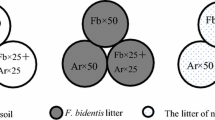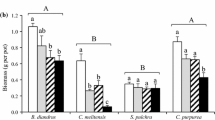Abstract
Because the fate of seeds is critical to understanding the invasion of old fields by trees, and plant litter is an important component defining the old field microsite of dispersed seeds, I investigated the effects of litter type (Solidago spp./goldenrod,Quercus spp./oak, mixed) and litter amount (100–800 g/m2) on tree seed germination and seedling emergence. I found that at all densities bothSolidago andQuercus litter greatly reduced emergence of the small-seeded, bird-dispersed species,Juniperus virginiana andCornus florida. For one of the large-seeded, mammal-dispersed species,Carya tomentosa, high densitySolidago litter and high density mixed litter treatments reduced emergence. For the other large-seeded species,Quercus rubra, the high density mixed litter treatment and all levels ofSolidago litter reduced emergence.Quercus seedlings emerged twice as often as the other three species in control pots without litter.Carya emerged before the other species but the high density oak treatment delayed the expansion of its cotyledons. My results suggest that litter may contribute to the slow rate of tree invasion and the low probability of tree establishment in old fields. However, old field litter studies taken together point to the difficulty in drawing general conclusions about any ‘net effect’ of litter on old field tree establishment.
Similar content being viewed by others
References
Abbott, H. G. & Quink, T. F. 1970. Ecology of eastern white pine seed caches made by small forest mammals. Ecology 51: 271–278.
Bard, G. E. 1952. Secondary succession on the Piedmont of New Jersey. Ecological Monographs 22: 195–215.
Barrett, L. I. 1931. Influence of forest litter on the germination and early survival of chestnut oak,Quercus montana Willd. Ecology 12: 476–484.
Bazzaz, F. A. 1968. Succession on abandoned fields in the Shawnee Hills, Southern Illinois. Ecology 49: 924–936.
Buell, M. F., Buell, H. F., Small, J. A. & Siccama, T. G. 1971. Invasion of trees in secondary succession on the New Jersey piedmont. Bulletin of the Torrey Botanical Club 98: 67–74.
Burton, P. J. 1982. The effects of temperature and light onMetrosideros polymorpha seed germination. Pacific Science 36: 229–240.
Burton, P. J. & Bazzaz, F. A. 1991. Tree seedling emergence on interactive temperature and moisture gradients and in patches of old-field vegetation. American Journal of Botany 78: 131–149.
Connell, J. H., Noble, I. R. & Slatyer, R. O. 1987. On the mechanisms producing successional change. Oikos 50: 136–137.
Facelli, J. M. & Carson, W. P. 1991. Heterogeneity of plant litter accumulation in successional communities. Bulletin of the Torrey Botanical Club 118: 62–66.
Facelli, J. M. & Pickett, S. T. A. 1991a. Plant litter: Its dynamics and effects on plant community structure. The Botanical Review 57: 1–32.
Facelli, J. M. & Pickett, S. T. A. 1991b. Plant litter: light interception and effects on an oldfield plant community. Ecology 72: 1024–1031.
Fenner, M. 1985. Seed Ecology. Chapman and Hall, New York, USA.
Fowells, H. A. 1965. Silvics of forest trees of the United States. USDA Forest Service Agricultural Handbook No. 271, 762 p.
Florence, R. G. 1965. Decline of old-growth redwood forests in relation to some soil microbiological processes. Ecology 46: 52–64.
Gaines, S. D. & Rice, W. R. 1990. Analysis of biological data when there are ordered expectations. American Naturalist 135: 310–317.
Gill, D. S. & Marks, P. L. 1991. Tree and shrub seedling colonization of old fields in central New York. Ecological Monographs 61: 183–206.
Gholz, H. L., Hawk, G. M., Campbell, A., Cromack, K. & Brown, A. T. 1985. Early vegetation recovery and element cycles on a clearcut watershed in western Oregon. Canadian Journal of Forestry Research 15: 400–409.
Gleason, H. A. & Cronquist, A. 1963. Manual of Vascular Plants of Northeastern United States and Adjacent Canada. D. Van Nostrand Company, New York, USA.
Grime, J. P. 1979. Plant strategies and vegetation processes. John Wiley and Son, New York.
Gross, K. L. & Werner, P. A. 1982. Colonizing abilities of biennial plant species in relation to ground cover: Implications for their distributions in a successional sere. Ecology 63: 921–931.
Hamrick, J. L. & Lee, J. M. 1987. Effect of soil surface topography and litter cover on the germination, survival and growth of musk thistle (Carduus nutans). American Journal of Botany 74: 451–457.
Livingston, R. B. & Allessio, M. L. 1968. Buried viable seed in successional field and forest stands, Harvard Forest, Massachusetts. Bulletin of the Torrey Botanical Club 95: 58–69.
McCarthy, B. C. & Facelli, J. M. 1990. Microdisturbances in old fields and forests: Implications for woody seedling establishment. Oikos 58: 27–33.
Monk, C. D. & Gabrielson, F. C. 1985. Effects of shade, litter and root competition on old field vegetation in South Carolina. Bulletin of the Torrey Botanical Club 112: 383–392.
Myster, R. W. & Pickett, S. T. A. 1992. Effects of palatability and dispersal mode on spatial patterns of trees in old fields. Bulletin of the Torrey Botanical Club 119: 145–151.
Myster, R. W. & Pickett, S. T. A. 1993. Effects of litter, distance, density and vegetation patch type on postdisperal tree seed predation in old fields. Oikos 66: 381–388.
Myster, R. W. 1993. Tree invasion and establishment in old fields at Hutcheson Memorial Forest. The Botanical Review 59: 251–272.
Oosting, H. J. & Humphreys, M. E. 1940. Buried viable seeds in a successional series of old field and forest soils. Bulletin of the Torrey Botanical Club 67: 253–273.
Peterson, C. & Facelli, J. M. 1992. Contrasting germination and seedling growth ofBetula alleghaniensis andRhus typhina subjected to various amounts and types of plant litter. American Journal of Botany 79: 1209–1216.
Pickett, S. T. A. 1982. Population patterns through twenty years of oldfield succession. Vegetatio 49: 45–59.
Pons, T. L. 1989. Breaking of seed dormancy by nitrate as a gap detection mechanism. Annals of Botany 63: 139–143.
Price, M. V. & Jenkins, S. H. 1986. Rodents as seed consumers and dispersers. In: Murray, DR (ed) Seed dispersal. Academic Press, New York. pp 191–236.
Runkle, J. R. 1985. Disturbance regimes in temperate forests. In: Pickett, S. T. A. & White, P. S. (eds) The ecology of natural disturbance and patch dynamics. Academic Press, Orlando, FL. pp 17–34.
SAS 1985 SAS/STAT User's Guide. Release 6.03 Edition. SAS Institute Inc., CARY, NC
Schopmeyer, C. S. 1974. Seeds of woody plants in the United States. Handbook no.450. Forest Service, USDA, Washington, D.C, USA.
Sork, V. L. 1983. Distribution of pignut hickoryCarya glabra along a forest to edge transect and factors affecting seedling recruitment. Bulletin of the Torrey Botanical Club 10: 494–506.
Spence, D. H. 1982. The zonation of plants in fresh water lakes. Advances in Ecological Research 12: 37–125.
Sydes, C. & J. P.Grime. 1981. Effects of tree litter on herbaceous vegetation in the deciduous woodlands. II An experimental investigation. Journal of Ecology 69: 249–262.
Van derValk, A. G. 1974. Environmental factors controlling the distribution of forbs on coastal foredunes in Cape Hatteras National Seashore. Canadian Journal of Botany 52: 1057–1073.
Van derValk, A. G. 1986. The impact of litter and annual plants on recruitment from the seed bank of a lacustrine wetland. Aquatic Botany 24: 13–26.
Vazquez-Yanes, C., A.Orozco-Segovia, E.Rincon, M. E.Sanchez-Coronado, P.Huante, J. R.Toledo & V. L.Barradas. 1990. Light beneath the litter in a tropical forest: Effect on seed germination. Ecology 71: 1952–1958.
Author information
Authors and Affiliations
Rights and permissions
About this article
Cite this article
Myster, R.W. Contrasting litter effects on old field tree germination and emergence. Vegetatio 114, 169–174 (1994). https://doi.org/10.1007/BF00048396
Accepted:
Issue Date:
DOI: https://doi.org/10.1007/BF00048396




